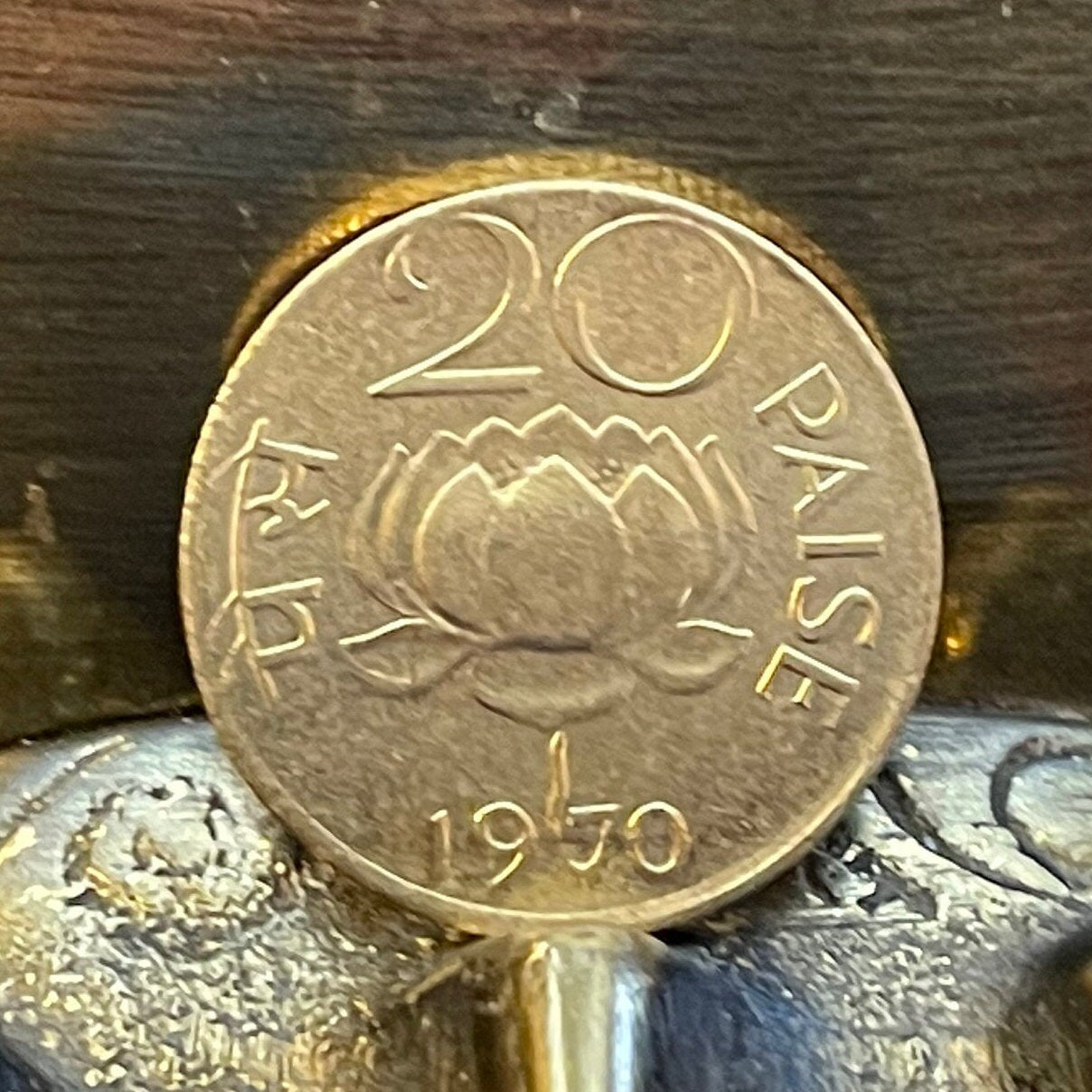elemintalshop
Ashoka Lion Capitol & Lotus Blossom 20 Paise India Authentic Coin Money for Jewelry and Craft Making
Ashoka Lion Capitol & Lotus Blossom 20 Paise India Authentic Coin Money for Jewelry and Craft Making
Couldn't load pickup availability
Ashoka Lion Capitol & Lotus Blossom 20 Paise India Authentic Coin Charm for Jewelry and Craft Making
Obverse: Ashoka lion capitol with the country name on both sides
Lettering: भारत INDIA
Translation: India India
Reverse: A lotus blossom with the denomination above and on the sides and the date above the mintmark below
Lettering:
20
पैसे PAISE
Translation:
20
Paise Paise
Features
Issuer India
Period Republic (1950-date)
Type Standard circulation coin
Years 1968-1971
Value 20 Paise (0.2 INR)
Currency Rupee (decimalized, 1957-date)
Composition Nickel brass
Weight 4.6 g
Diameter 22 mm
Thickness 1.75 mm
Shape Round
Orientation Medal alignment ↑↑
Demonetized 06-30-2011
Number N# 1622
References KM# 41
Wikipedia:
The Lion Capital of Ashoka is a sculpture of four Asiatic lions standing back to back, on an elaborate base that includes other animals. A graphic representation of it was adopted as the official Emblem of India in 1950. It was originally placed on the top of the Ashoka pillar at the important Buddhist site of Sarnath by the Emperor Ashoka, in about 250 BCE during his rule over the Maurya Empire. The pillar, sometimes called the Aśoka Column, is still in its original location, but the Lion Capital is now in the Sarnath Museum, in the state of Uttar Pradesh, India. Standing 2.15 metres (7 feet) high including the base, it is more elaborate than the other very similar surviving capitals of the pillars of Ashoka bearing the Edicts of Ashoka that were placed throughout India several of which feature single animals at the top; one other damaged group of four lions survives, at Sanchi.
The capital is carved out of a single block of polished sandstone, and was always a separate piece from the column itself. It features four Asiatic Lions standing back to back. They are mounted on an abacus with a frieze carrying sculptures in high relief of an elephant, a galloping horse, a bull, and a lion, separated by intervening spoked chariot-wheels. The whole sits upon a bell-shaped lotus. The capital was originally crowned by a 'Wheel of Dharma' (Dharmachakra popularly known in India as the "Ashoka Chakra"), with 32 spokes, of which a few fragments were found on the site. A 13th-century replica of the Sarnath pillar and capital in Wat Umong near Chiang Mai, Thailand built by King Mangrai, preserves its crowning Ashoka Chakra or Dharmachakra. The wheel on the capital, below the lions, is the model for the one in the flag of India.
********
Wikipedia:
The lotus, Nelumbo nucifera, is an aquatic plant that plays a central role in the art of Indian religions such as Hinduism, Buddhism, Sikhism, and Jainism.
In Asian art a lotus throne is a stylized lotus flower used as the seat or base for a figure. It is the normal pedestal for divine figures in Buddhist art and Hindu art, and often seen in Jain art. Originating in Indian art, it followed Indian religions to East Asia in particular.
Hindus revere it with the divinities Vishnu and Lakshmi often portrayed on a pink lotus in iconography; historically, many deities namely Brahma, Saraswati, Lakshmi, Kubera usually sit on a stylized lotus throne. In the representation of Vishnu as Padmanabha (Lotus navel), a lotus issues from his navel Brahma on it. The goddess Saraswati is portrayed on a white-colored lotus. The lotus is the symbol of what is divine or immortal in humanity, and is also a symbol of divine perfection. The lotus is the attribute of sun and fire gods. It symbolizes the realization of inner potential and in Tantric and Yogic traditions the lotus symbolizes the potential of an individual to harness the flow of energy moving through the chakras ( often depicted as wheel like lotuses) flowering as the thousand -petaled lotus of enlightenment at the top of the skull.
Vishnu is often described as the "Lotus-Eyed One" (Pundarikaksha). The lotus's unfolding petals suggest the expansion of the soul. The growth of its pure beauty from the mud of its origin holds a benign spiritual promise. In Hindu iconography, other deities, like Ganga and Ganesha are often depicted with lotus flowers as their seats.
The lotus plant is cited extensively within Puranic and Vedic literature, for example:
One who performs his duty without attachment, surrendering the results unto the Supreme Lord, is unaffected by sinful action, as the lotus is untouched by water.
— Bhagavad Gita 5.10:
Share









Great coins and wonderful service.
Wonderful service with great coins.
As described; safe and prompt.
Item as described, arrived safely and promptly. Thank you.
Shipped quickly. Coin is exactly as described.
Thank you.








